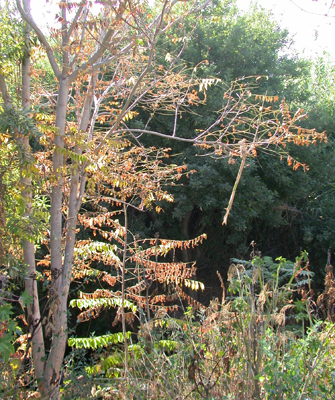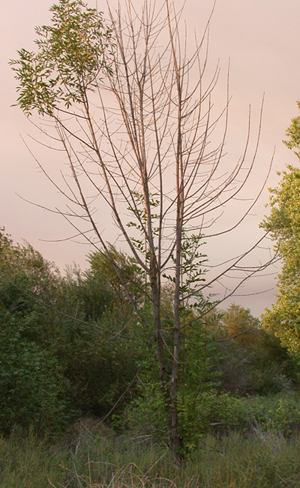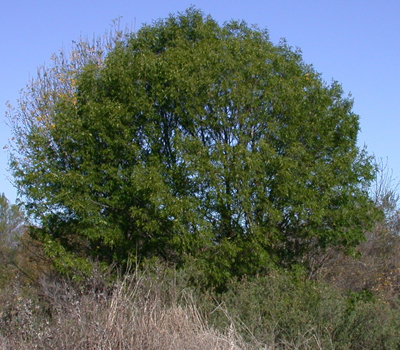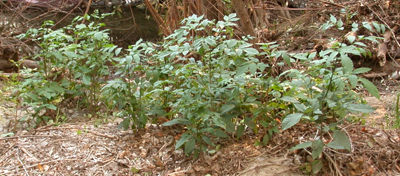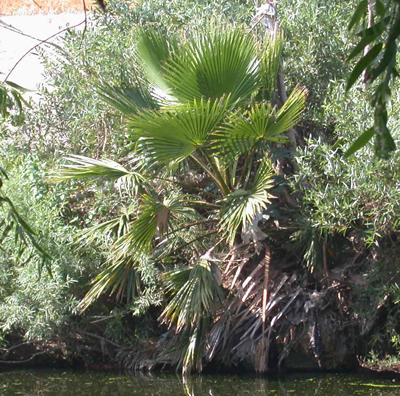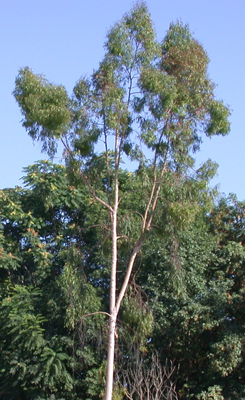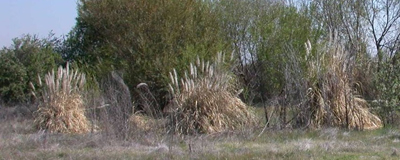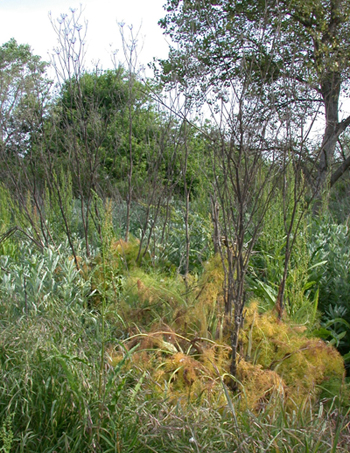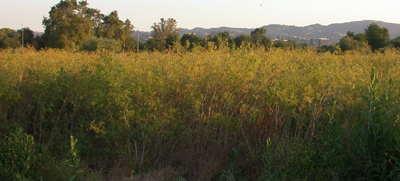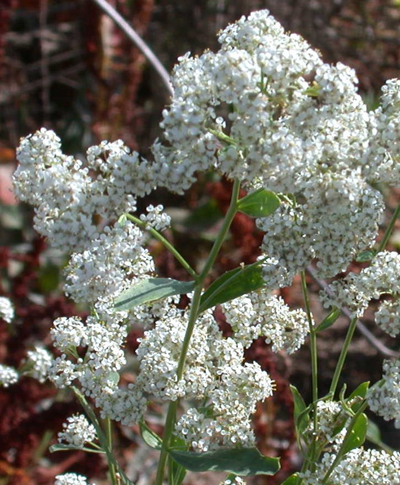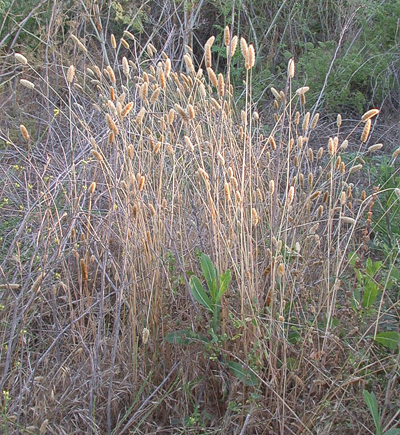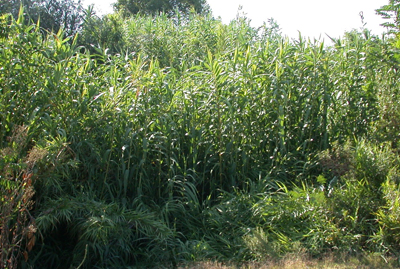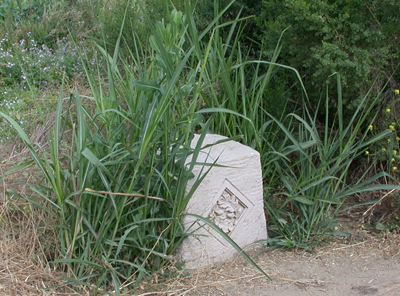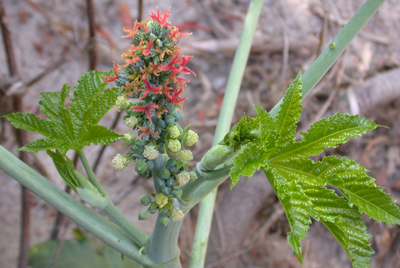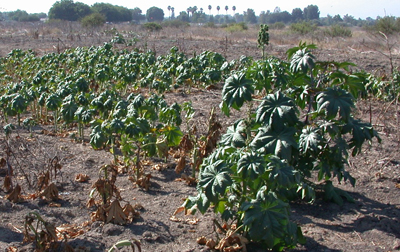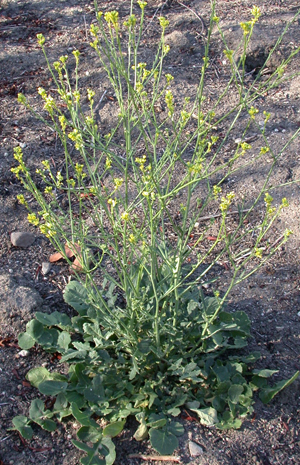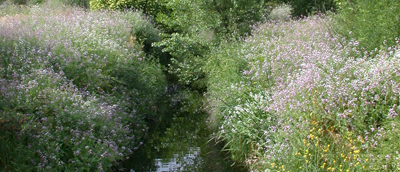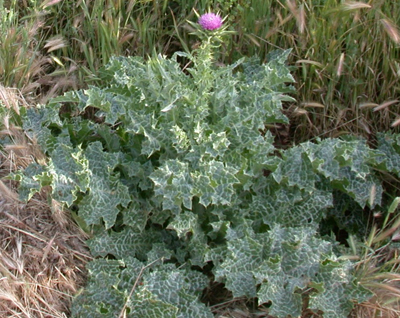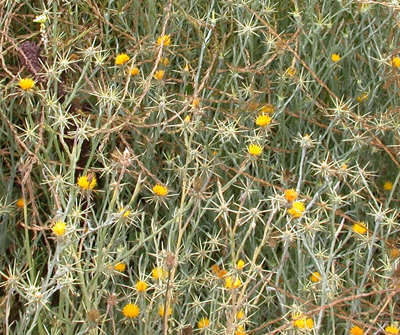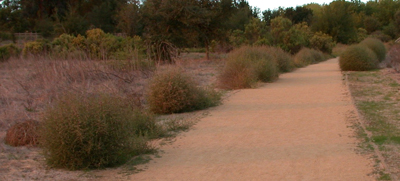COMMON WEEDS AND EXOTIC PLANTS IN THE SEPULVEDA BASIN WILDLIFE RESERVE |
|||||||||||||
Weeds in the Sepulveda Basin Wildlife Area are controlled mostly by systemic herbicide spraying by a licensed and experienced applicator; hand pulling is sometimes used by volunteer groups. Both the City of Los Angeles and the Sepulveda Basin Wildlife Areas Consortium (of environmental groups) has provided funding for the herbicide application. Every consideration is given to reduce the possibility that poisons will enter the ecosystem. The scale of the weed problems in the Basin makes it impossible to control the weeds without the use of herbicide. Neither the City of Los Angeles nor the Corps of Engineers has full-time weed control personnel available in the Sepulveda Basin. |
||
Exotic Trees |
||
Tree of heaven (Ailanthus altissima) - Quassia Family |
||
This very invasive tree originally native to eastern Asia was cultivated as a street tree, but it spreads by seeds and by invasive roots. It grows rapidly up to 65 feet tall. In the Basin it invades riparian corridors. |
||
Evergreen ash (Fraxinus uhdei) - Olive Family |
||
Evergreen (or Shamel) ash is another street tree that has turned out to be an invasive nightmare. This is a fast growing tree that gets taller than the native riparian willows, and in Haskell Creek (South Reserve) the evergreen ash trees are creating a shade canopy that will eventually smother the native vegetation. This plant can be confused with native velvet ash except during the winter then the native plants lose their leaves. |
||
Mexican Fan Palm (Washingtonia robusta) - Palm Family |
||
The Mexican fan palm is a common street and landscape tree in the San Fernando Valley. In the fall and winter each tree can produce thousands of oily, black fruits that are very popular with certain birds. The birds eat the fruits and then pass the round seeds. These seeds germinate easily, and little palm trees end up sprouting everywhere, especially in the riparian areas of the Reserve. Another palm tree, the California fan palm (Washingtonia filifera) that is native to desert oases, also is used as a landscaping tree and shows up in the Basin. The California fan palm is considered a weed in the Sepulveda Basin Wildlife Reserve. |
||
Eucalyptus (Eucalyptus spp.) - Myrtle Family |
||
Both the red gum (Eucalyptus camaldulensis) and blue gum (Eucalyptus globosus) are found in the Reserve. These trees are problematic in that their leaves have chemicals that eventually render the soil not conducive for native plants, and they drop plenty of seeds that eventually create eucalyptus forests and displace native plants. There are quite a few mature eucalyptus trees in the South Reserve and along Haskell Creek north of the Wildlife Reserve. Eucalyptus are native to Australia. |
||
Non-native Shrubs and Perennials |
||
Pampas grass (Cortaderia spp.) - Grass Family |
||
This gigantic (up to 20 feet tall) perennial grass is very invasive but fortunately not prevalent in the Sepulveda Basin. It is native to South America. Because it is commonly planted as an ornamental shrub and produces thousands of seeds, there will always be the possibility of it showing up in any disturbed site in the Reserve. However it is easily controlled with herbicide. |
||
Fennel (Foeniculum vulgare) - Carrot Family |
||
Fennel (sometimes incorrectly called anise) is another useful plant imported from Europe, but in southern California’s Mediterranean climate, the plant can invade natural areas and replace all the native plants. Infestations in the North Reserve around the Wildlife Lake have been mostly eradicated. In other areas of the Reserve fennel persists in places, and when these areas are identified these populations are treated with herbicide. |
Poison hemlock (Conium maculatum) - Carrot Family |
||
Not a true perennial, poison hemlock is a biennial, the first year putting up a small sprout, and the second year pushing up a tall stalk (up to 10 foot tall). The stems are purple-spotted and blooms with white flowers in an umbel – the distinctive inflorescence of the carrot family. This is the same plant used in ancient Greece for capital punishment (e.g. Socrates). Poison hemlock has always been common along Haskell Creek, as it thrives in moist areas. But now it shows up on the edges of the Wildlife Lake, in moist areas in the South Reserve, and, due to the compensating excavation in the portion west of Haskell Creek, it is becoming the dominant weed in that area. It really shouldn’t be touched due to the presence of highly toxic alkaloids in the plant. |
||
Perennial pepperweed (Lepidium latifolium) - Mustard Family |
||
Native to Eurasia, perennial pepperweed (Lepidium latifolium) is a multi-stemmed herb that grows three to eight feet tall with a heavy, sometimes woody, crown and a spreading underground root system. Stems and leaves are dull gray-green and waxy, sometimes with reddish spots. The tiny white flowers are borne in dense clusters at the tops of the stems. Flowering from May to July, plants produce many small, roundish, light brown fruits. This plant has invaded and infested many riparian areas in northern California, and is moving south. The first infestation of perennial pepperweed was found in the South Reserve in the area nearest to the dam that is frequently disked by the Corps of Engineers. Ongoing herbicide control efforts will attempt to keep this incredibly invasive plant out of the Basin. |
||
Harding grass (Phalaris aquatica) |
||
Harding grass is an erect, stout perennial grass with grayish to bluish green leaves. Flowering heads are dense, spike-like, and usually two to five inches long. It is slow to develop from seed, but can form large bunches after several years. This perennial grass is native to Mediterranean Europe. It has invaded wet areas at the edge of the Wildlife Lake. It is being controlled with herbicide. |
||
Giant reed (Arundo donax) - Grass Family |
||
With stems that can grow over 20 feet tall, and plants that can spread to be as large as a truck, giant reed is daunting invader. After invading the Los Angeles River and Bull Creek in the 1980’s and 1990’s, in 2001 the Corps of Engineers brought in heavy equipment to rip the giant plants out of the earth along the L.A. River between Burbank Blvd. and Balboa Ave. Giant reed has been pretty much eradicated from the Wildlife Reserve, but every so often a plant will be seen shooting up above the native plants, and that outbreak will be treated with herbicide. Giant reed is also prevalent along Encino and Bull Creeks, and both of these areas are monitored and treated with herbicide. Giant reed becomes a severe fire threat when large stands accumulate a lot of dead material. |
||
<insert photos of arundo removal> |
||
Johnson grass (Sorghum halepense) - Grass Family |
||
This perennial grass from the Mediterranean region of Europe is very invasive in disturbed areas, ditchbanks and roadsides. The giant clumps (sometimes reaching 6 feet tall) cannot be removed by hand, so herbicide is applied. |
||
Castor bean (Ricinus communis) - Spurge Family |
||
Castor bean, another European native, can grow to a large shrub up to 10 feet tall. It is highly toxic, and the source of the poison ricin. This weed used to be common in the Basin, but an ongoing eradication campaign spearheaded by Bill Neill, has reduced the castor bean problem to occasional young plants that are easier to control. |
||
Annual Invasive Weeds |
||
Mustards (Brassica nigra, Hirschfeldia incana) - Mustard Family |
||
Wild mustards, native to Europe, are common in southern California. Black mustard seeds creates the mustard spice that goes on your hot dog. Hirschfeldia incana (no common name) is a look alike that also occurs in the Wildlife Reserve. This plant is tolerated in the Wildlife Reserve, but it is thought that these non-native mustards change the soil in a way that hinders the success of native plants. It would look better if mustard was eradicated along the trails on either side of Haskell Creek in the North Reserve. |
||
Wild radish (Raphanus sativa) - Mustard Family |
||
The radish is an edible root vegetable that was domesticated in Europe in pre-Roman times. They are grown and consumed throughout the world. The plant grows along with the mustards in many areas of the Reserve. |
||
Milk thistle (Silybum marianum) - Sunflower Family |
||
In 1989 the first weeding efforts took place in the Wildlife Reserve, led by Mima Parra-Szijj of the Corps of Engineers. There was a big milk thistle infestation near the north entrance to the Reserve. In those days volunteers used shovels or hand-pulled the thistles. Since then, milk thistle has remained a high priority weed for control, because left to itself it will eventually form large monoculture stands of milk thistle. The 2002 fire disturbed the soil in many areas and some large patches of milk thistle came up after the fire, in areas where the thistle hadn’t been seen previously. Milk thistle control will be an ongoing project. |
||
Yellow star thistle (Centaurea solstitialis) - Sunflower Family |
||
Yellow star thistle is the bigger, nastier, meaner sibling of tocalote. Its flowers have inch-long spines that can be very painful, and the plant is cumulatively toxic to horses if eaten. Fortunately this plant has only been found in the South Reserve in the disturbed areas near the dam face. |
||
Russian thistle, tumbleweed (Salsola sp.) - Goosefoot Family |
||
Incorrectly associated with the “old west,” the tumbleweed is from Eurasia, introduced to the United States via grain shipments in the late-1800’s. This plant likes disturbed areas, and fire is a type of disturbance. In the early days of the Wildlife Reserve Russian thistle was a big problem. It was less of a problem until the expansion of 1999 disturbed a lot of soil, and then the fire of 2002 created a different kind of disturbance. In 2008 a huge infestation was discovered in the northeast portion of the North Reserve, caused in part by the City allowing tumbleweeds to grow in an unused area just west of the archery range north of the Wildlife Reserve. Russian thistle is also prevalent west of Haskell Creek. |
||

